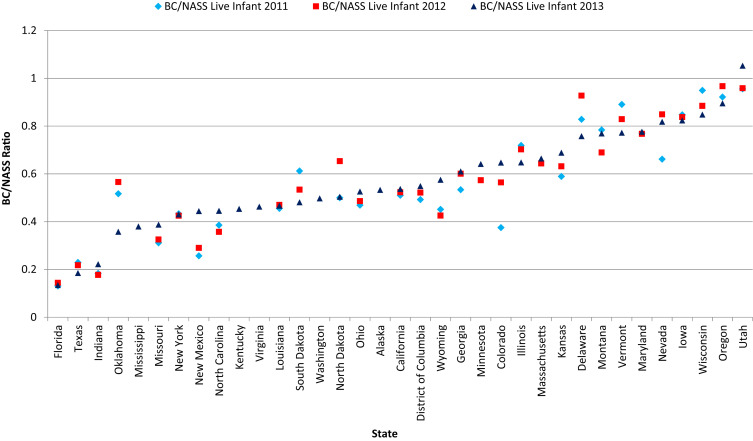Introduction
Since 1900 the birth certificate has been a valuable source of information regarding pregnancy outcomes in the United States. In 2003, the US Standard Certificate of Live Birth was modified to include information regarding infertility treatments leading to conception. These include assisted reproductive technologies (ART) such as in vitro fertilization, intracytoplasmic sperm injection, and gamete and zygote intrafallopian transfer procedures, as well as non-ART treatments including fertility-enhancing drugs, artificial insemination, and intrauterine insemination. These revisions were only fully adopted across all US jurisdictions (states and the District of Columbia) in 2015. This process included use of new worksheets for parents and hospital personnel and electronic data collection. However, birth certificate data reported to the National Center for Health Statistics (NCHS) have been reported to vary significantly from state to state with respect to accuracy of ART reporting. In contrast, the National ART Surveillance System (NASS) of the Centers for Disease Control and Prevention captures about 98% of ART procedures but contains limited data on maternal and infant outcomes compared to the birth certificate. Thus the NASS data, while more accurate with respect to reporting of ART prevalence, are less useful in identifying pregnancy complications related to ART. The purpose of this report is to update previous data and evaluate state-by state performance of NCHS birth certificate ART reporting.
Materials and Methods
We compared state-specific live birth data regarding the use of ART as reported by the NASS with that recorded on NCHS birth certificates from 2011 through 2013. These NASS data are derived from published summary reports rather than representing raw data, or linkage to vital statistics. All patients from the NCHS database who received infertility treatment with ART were identified. We calculated the state-specific ratios of ART-related live births by dividing the number of live infants resulting from ART in the NASS database by the number of ART live births as reported in the NCHS birth certificate database. A ratio near 1.0 would indicate excellent state performance in ART reporting on birth certificates.
Materials and Methods
We compared state-specific live birth data regarding the use of ART as reported by the NASS with that recorded on NCHS birth certificates from 2011 through 2013. These NASS data are derived from published summary reports rather than representing raw data, or linkage to vital statistics. All patients from the NCHS database who received infertility treatment with ART were identified. We calculated the state-specific ratios of ART-related live births by dividing the number of live infants resulting from ART in the NASS database by the number of ART live births as reported in the NCHS birth certificate database. A ratio near 1.0 would indicate excellent state performance in ART reporting on birth certificates.
Results
From 2011 through 2013, an increasing number of states (27 states and the District of Columbia, representing 67% of live births in 2011 vs 34 states and the District of Columbia, representing 78.7% of live births in 2013) collected ART information on birth certificates. On the basis of NASS data in states that had adopted the 2003 NCHS birth certificate revision, 38,496; 44,735; and 50,069 infants were born with the use of ART in 2011, 2012, and 2013, respectively. During the same years there were 18,560; 22,726; and 25,465 live births classified as ART pregnancies in NCHS birth certificate data representing 48%, 51%, and 51% reporting correlation. The Figure shows the state-specific ratio of live births resulting from ART in NASS data compared with birth certificate data, United States, 2011 through 2013. A wide range of state-specific correlations was identified and has persisted (0.13 for Florida to 0.96 for Utah in 2011, 0.14 for Florida to 0.97 for Oregon in 2012, and 0.13 for Florida to 1.1 for Utah in 2013).





